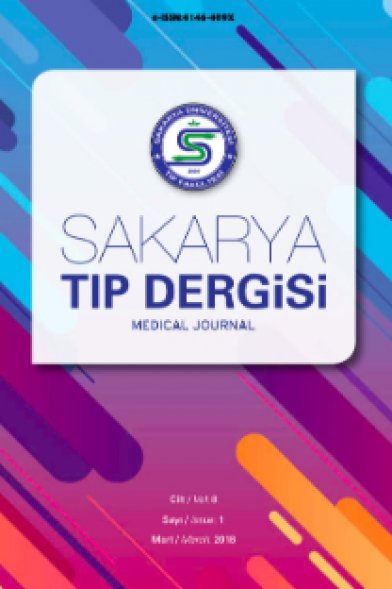Biküspit Aort Kapak Hastalarında Kırmızı Hücre Dağılım Aralığı Ile Asendan Aort Çapı Arasındaki Ilişki
Relation of Red Cell Distribution Widht with Ascending Aortic Diameter in Bicuspid Aortic Valve Patients
___
- 1. Roberts WC. The congenitally bicuspid aortic valve. A study of 85 autopsy cases. Am J Cardiol 1970;26:72–83.
- 2. Sabet HY, Edwards WD, Tazelaar HD, Daly RC. Congenitally bicuspid aortic valves: a surgical pathology study of 542 cases (1991 through 1996) and a literature review of 2,715 additional cases. Mayo Clin Proc 1999;74:14–26.
- 3. Nistri S, Sorbo MD, Marin M, Palisi M, Scognamiglio R, Thiene G. Aortic root dilatation in young men with normally functioning bicuspid aortic valves. Heart 1999;82:19–22.
- 4. Beroukhim RS, Kruzick TL, Taylor AL, Gao D, Yetman AT. Progression of aortic dilation in children with a functionally normal bicuspid aortic valve. Am J Cardiol 2006;98:828–30.
- 5. Kang JW, Song HG, Yang DH, Baek S, Kim DH, Song JM et al. Association between bicuspid aortic valve phenotype and patterns of valvular dysfunction and bicuspid aortopathy: comprehensive evaluation using MDCT and echocardiography. JACC Cardiovasc Imaging 2013;6:150– 61.
- 6. Della Corte A, Bancone C, Buonocore M, Dialetto G, Covino FE, Manduca Set al. Pattern of ascending aortic dimensions predicts the growth rate of the aorta in patients with bicuspid aortic valve. JACC Cardiovasc Imaging 2013;6:1301–10.
- 7. Cem Ö, Yilmaz S, Korkmaz A, Fahrettin T, Sahin I, Demir V. Evaluation of the neutrophil-lymphocyte ratio in newly diagnosed nondiabetic hypertensive patients with ascending aortic dilatation. Blood Press Monit. 2016 Aug;21(4):238-43.
- 8. Güngör B, Özcan KS, Özpamuk Karadeniz F, Uluganyan M, Ekmekçi A, Alper AT, et al. Red cell distribution widht is increased in patients with ascending aortic dilatation. Turk Kardiyol Dern Ars. 2014 Apr;42(3):227- 35.
- 9. Förhécz Z, Gombos T, Borgulya G, Pozsonyi Z, Prohászka Z, Jánoskuti L. Red cell distribution width in heart failure: prediction of clinical events and relationship with markers of ineffective erythropoiesis, infl ammation, renal function, and nutritional state. Am Heart J 2009;158:659-66.
- 10. Roberts WC. The congenitally bicuspid aortic valve: a study of 85 autopsy studies.Am J Cardiol. 1970;26(1):72-83.
- 11. Hiratzka LF, Bakris GL, Beckman JA, Bersin RM, Carr VF, Casey DE Jr, et al. 2010 ACCF/AHA/AATS/ACR/ASA/SCA/SCAI/SIR/STS/SVM guidelines for the diagnosis and management of patients with Thoracic Aortic Disease: a report of the American College of Cardiology Foundation/ American Heart Association Task Force on Practice Guidelines, American Association for Thoracic Surgery, American College of Radiology, American Stroke Association, Society of Cardiovascular Anesthesiologists, Society for Cardiovascular Angiography and Interventions, Society of Interventional Radiology, Society of Thoracic Surgeons, and Society for Vascular Medicine. Circulation 2010;121:266-69.
- 12. Fedak PW, Verma S, David TE, Leask RL, Weisel RD, Butany J. Clinical and pathophsiological implications of a bicuspid aortic valve.Circulation. 2002;106(8):900-04.
- 13. Michelena HI, Desjardins VA, Avierinos JF, Russo A, Nkomo VT, Sundt TM, et al. Natural history of asymptomatic patients with normally functioning or minimally dysfunctional bicuspid aortic valve in the community. Circulation 2008;21:2776-84.
- 14. Hiratzka LF, Creager MA, Isselbacher EM, Svensson LG, Nishimura RA, Bonow RO, et al. Surgery for Aortic Dilatation in Patients With Bicuspid Aortic Valves: a statement of clarifi cation from the American College of Cardiology/American Hear Associatiın Task force on Clinical Practice Guidelines. J Am Coll Cardiol. 2016 Feb 16;67(6):724-31.
- 15. K. Clarke, R. Sagunarthy, and S. Kansal. RDW as an additional marker in infl ammatory bowel disease/undifferentiated colitis. Digestive Diseases and Sciences 2008;53:2521-23.
- 16. Mawlana W, Donia A, Elamrousy D. Relation between red cell distribution width and left ventricular function in children with heart failure. ISRN Pediatrics 2014;2014:234835.
- 17. Kojima T, Yasuhara J, Kumamoto T, Shimizu H, Yoshiba S, Kobayashi T, Sumitomo N. Usefulness of the red blood cell distribution width to predict heart failure in patients with a Fontan circulation. Am J Cardiol 2015;116:965–68.
- 18. Polat V, Iscan S, Etli M, El Kılıc H, G? ursu O, Eker E, Ozdemir F. Red cell distribution width as a prognostic indicator in pediatric heart disease and after surgery. Biomed Res Int 2014;2014:681679.
- 19. Rodriguez-Carrio J, Alperi-Lopez M, Lopez P, Alonso-Castro S, Carro- Esteban SR, Ballina Garcia FJ, Suarez A. Red cell distribution width is associated with endothelial progenitor cell depletion and vascularrelated mediators in rheumatoid arthritis. Atherosclerosis 2015;240:131–36.
- Yayın Aralığı: 4
- Başlangıç: 2011
- Yayıncı: Sakarya Üniversitesi
Serdar Deniz, Dilek Öztaş, Muhsin Akbaba
Prostatik Adenkarsinomlarda Mast Hücrelerinin Triptaz ve Kimaz Ekspresyon Farklılıkları
Handan ANKARALI, Ali ASLAN, Havva ERDEM, Feyza BAŞAR, Nilüfer KADIOĞLU, Hilal BALTA
Ersin NAZLICAN, Muhsin AKBABA, Elif DURMAZD
Üniversite Çalışanlarında Siberkondria Düzeyleri ve İlişkili Faktörlerin İncelenmesi
Selma ALTINDİŞ, Mustafa Baran İNCİ, Ferhat Gürkan ASLAN, Mustafa ALTINDİŞ
Muhammed Cihad ÇELİK, Serdal BAŞTUĞ, Abdullah Nabi ASLAN, Hacı Ahmet KASAPKARA, Mehmet Murat YİĞİTBAŞI, Yunus Emre ÖZBEBEK, Engin BOZKURT
Hakkı Çağdaş BASAT, Berk GÜÇLÜ, Ömer BOZDUMAN, Yasin KÖKER, Cihan KIRÇIL, Hicabi SEZGİN
Glioblastoma Multiforma Tedavisinde Kanser Kök Hücrelerinin Temozolomide Karşı Oluşturdukları Direnç
İkiz Eşlerinde Rotavirüs Gastroenteriti ile İlişkili Afebril Konvülziyon: Olgu Sunumu
Ali GÜNGÖR, İsmail Çağrı AÇIKGÖZ, Özlem MUSTAFAOĞLU, Arif İsmet ÇATAK, Esra Gürkaş, Bahar Çuhacı Çakır
